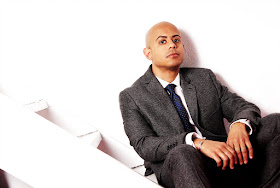 |
| Stewart Goodyear (Photo Andrew Garn) |
 |
| Stewart Goodyear (Photo Anita Zvonar) |
Stewart has lived with Ravel all his pianistic life, at the age of 8 whilst taking part in competitions he heard other contestants playing Ravel's piano music and was captivated by the sound-world. But it was only now that the time felt right to record the music, and he went with the gut feeling. The new disc records pieces written by Ravel in the first decade of the composer's career (1899-1909). Stewart explains that he was fascinated by Ravel before he became well known outside France, and the music was often revolutionary and controversial.
Stewart calls the music a roller coaster ride, the pieces he has recorded include Miroirs and Gaspard de la nuit.
He loves the music so simply embraced the technical challenges of the music, and in fact found it was the recording process itself which was the challenge. Whilst working on Gaspard he needed to concentrate on conveying what each movement was about.
Rather than other pianists, it is the composer's orchestrations to which Stewart has listened, to inform his playing style. He has been listening to such orchestral works as Valse nobles et sentimentales and Daphnis et Chloe, and he comments that when listening to Bolero you anticipate each repetition because of the differences in orchestral colours which Ravel uses.
Stewart is also a composer, this year he premiered his suite for piano and orchestra, Callaloo, with Kristjan Järvi and the MDR Symphony Orchestra in Leipzig, and in July of this year, the Clarosa Quartet will premiere his Piano Quartet commissioned by the Kingston Chamber Music Festival. I wondered how he managed to balance composition and piano playing? He practices during the daytime, and at night gets composition ideas. In fact he feels that creativity inspires him, so that whilst he was practising Ravel he wanted to try to see what he could create. He doesn't compose at the keyboard, and always has music paper with him whilst he is travelling. But Stewart is not a composer / pianist in the traditional mould and in fact when he premiered Callaloo it was the first time that he had performed some of his own music for a long time. He adds that he found the process rather scary, and it was something he had not done since he was 22.
Stewart is also an improviser, a process he sees as different to composition, he improvises at the keyboard and he feels that his improvisation helps keep his performances fresh. When doing repeat performances there are so many elements which are new each time, the concert hall, the acoustic, the audience, and improvisation helps a lot.
Stewart is Canadian of British-Trinidad inheritance and currently resident in Philadelphia. His training as a pianist started young and as a teenager he started studying at the Curtis Institute in Philadelphia, also studying at the Juilliard School. When he was five he first heard Beethoven's sonatas in chronological order, this was thanks to a boxed set of LPs (his first boxed set) performed by Vladimir Ashkenazy. He started listening at the beginning and worked his way through, riveted by what he heard. This early experience made him consider the 32 sonatas as one body of work; he talks about the feeling of getting into Beethoven's personal life very much like a diary. So individual sonatas did not seem to make sense unless in the context of the others, and for a long time he could not programme single sonatas. Out of this came the sonatathon, playing all of Beethoven's 32 sonatas in a single day. He was recently done his 5th sonatathon in Savannah, Georgia and describes it as cathartic and spiritual. He performs the sonatas in three groups, the first 10am to 2pm, and it is up to the audience to choose whether they come to one group or all, but many people choose to come to all of them.
We conclude our conversation by returning to Stewart's Ravel disc which he describes as a joy to make.
Stuart Goodyear: Ravel - Jeux d'eau, Sonatine, Miroirs, Gaspard de la nuit, Pavane pour un infante defunte - Orchid Classics . Available from Amazon.
Other Stewart Goodyear recordings:
Stewart Goodyear: Tchaikovsky - The Nutcracker (complete ballet arr. for solo piano). Available from Amazon.
Stewart Goodyear: Beethoven - Complete piano sonatas. Available from Amazon.
Stewart Goodyear, Heiko Mathias Forster, Czech National Symphony Orchestra: Rachmaninov - Piano Concertos nos. 2 & 3. Available from Amazon.
Stewart Goodyear: Beethoven - Late piano sonatas. Available from Amazon.
Elsewhere on this blog:
- Honesty and poise: Lise Davidsen at Rosenblatt Recitals - Concert review
- Striking new large-scale concert mass: Ståle Kleiberg's Mass for Modern Man - CD review
- A magic mystic contrivance: Mozart's The Magic Flute at the King's Head Theatre - Opera review
- Much to pique the interest: Springtime in Vienne from Wiener Symphoniker - CD review
- Pre-echoes and connections: Poulenc, McPhee, Adams from GrauSchumacher Piano Duo - CD review
- I think you love playing the violin: Kyung Wha Chung in conversation - feature article
- Welded into the national consciousness? Gilbert & Sullivan returns to London's opera houses - feature article
- Period charm: Original music for harp and piano from Duo Praxedis - CD review
- From study with Janacek in Brno to Terezin: Songs of Pavel Haas - CD review
- Virtuoso 17th century violin: Jonathan Cohen and Arcangelo in Biber, Schmelzer & Buxtehude - concert review
- Home


No comments:
Post a Comment